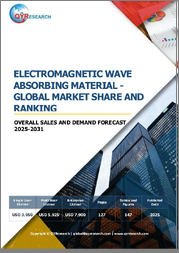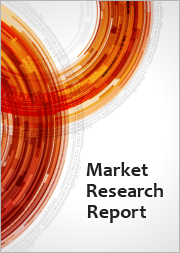
|
시장보고서
상품코드
1627927
고흡수성 폴리머 시장 기회, 성장 촉진요인, 산업 동향 분석, 예측(2024-2032년)Superabsorbent Polymer Market Opportunity, Growth Drivers, Industry Trend Analysis, and Forecast 2024 - 2032 |
||||||
세계의 고흡수성 폴리머 시장은 2023년에 84억 달러로 평가되며, 2024-2032년 CAGR 5.8%로 성장할 것으로 예측됩니다.
이 성장의 주요 원동력은 개인 건강과 위생에 대한 관심이 높아지면서 다양한 산업 분야에서 SAP 제품에 대한 수요가 증가하고 있으며, SAP는 주로 위생용품, 의료용품 등 높은 체액 흡수성을 필요로 하는 용도에 사용되고 있습니다.
건강과 위생에 대한 인식이 높아지고 의료비 증가로 인해 고흡수성 폴리머에 대한 수요가 크게 증가하고 있습니다. 소비자들은 더 나은 위생과 건강을 지원하는 제품을 선택함으로써 개인 관리 및 의료용 SAP의 소비 증가에 기여하고 있습니다. 또한 헬스케어에 대한 투자 확대는 기술 혁신을 촉진하여 보다 진보되고 효과적인 고흡수성 제품 개발로 이어지고 있습니다.
위생에 대한 인식, 특히 건강 위기의 여파는 시장 성장을 가속하는 또 다른 중요한 요인입니다. 위생 패드, 성인용 요실금 제품, 기저귀와 같은 제품은 청결에 대한 인식이 높아지면서 수요가 증가하고 있습니다. 또한 세계 인구 증가로 인해 식량 시스템이 압박을 받으면서 효율적인 농업 솔루션에 대한 수요가 증가하고 있습니다. 고흡수성 폴리머는 물 보존과 토양 관리에 필수적이며, 물 부족과 같은 문제를 해결하는 동시에 유기농 재배의 생산성을 지원하는 데 도움이 됩니다.
| 시장 범위 | |
|---|---|
| 개시년 | 2023 |
| 예측년 | 2024-2032 |
| 개시 금액 | 84억 달러 |
| 예측 금액 | 134억 달러 |
| CAGR | 5.8% |
시장은 폴리아크릴산 나트륨, 폴리아크릴아미드 공중 합체, 폴리 비닐 알코올, 다당류 등 여러 제품 범주로 나뉩니다. 폴리아크릴산 나트륨은 다량의 물을 흡수하는 뛰어난 능력으로 인해 2032년까지 가장 큰 시장 점유율을 차지할 것으로 예상되는 지배적 인 제품입니다. 따라서 위생용품에 특히 인기가 있습니다. 폴리아크릴아미드는 수처리 및 제지 공정에서 점점 더 많이 사용되어 시장을 주도하고 있습니다.
용도별로는 유아용 기저귀 분야가 가장 큰 비중을 차지하며 시장의 70%에 육박하는 점유율을 보이고 있습니다. 이 분야는 출산율 증가와 위생에 대한 인식이 높아짐에 따라 지속적으로 성장할 것으로 예상됩니다. 마찬가지로 세계 인구의 고령화와 요실금 문제에 대한 인식이 높아짐에 따라 성인용 요실금 제품 수요도 증가하고 있습니다.
미국 고흡수성 폴리머 시장은 예측 기간 중 연평균 5.1%의 성장률을 보이며 2032년까지 21억 달러에 달할 것으로 예상됩니다. 이러한 성장의 원동력은 위생 및 의료 분야의 SAP 수요 증가와 기저귀 및 요실금 패드와 같은 일회용 제품의 흡수성 및 성능 향상에 초점을 맞춘 기술 혁신에 의해 주도되고 있습니다.
목차
제1장 조사 방법과 조사 범위
제2장 개요
제3장 업계 인사이트
- 에코시스템 분석
- 밸류체인에 영향을 미치는 요인
- 이익률 분석
- 파괴
- 향후 전망
- 제조업체
- 유통업체
- 공급업체 상황
- 이익률 분석
- 주요 뉴스와 구상
- 규제 상황
- 영향요인
- 업계에 대한 영향요인
- 촉진요인
- 건강 의식의 향상과 의료비의 증가가 시장 성장을 지원한다.
- 위생에 관한 소비자 의식의 향상이 고흡수성 폴리머의 성장을 촉진할 전망
- 세계 인구의 증가에 수반하는 식품 수요의 증가
- 시장이 해결해야 할 과제
- 원재료 가격의 변동이 고흡수성 폴리머 시장의 성장을 방해할 것으로 예상된다.
- 촉진요인
- 규제와 시장에 대한 영향
- Porter의 산업 분석
- PESTEL 분석
제4장 경쟁 구도
- 서론
- 기업 점유율 분석
- 경쟁 포지셔닝 매트릭스
- 전략 전망 매트릭스
제5장 시장 규모·예측 : 제품별, 2021-2032년
- 주요 동향
- 폴리아크릴산 나트륨
- 유아용 기저귀
- 성인용 요실금 용품
- 여성용 위생용품
- 농업용
- 의료용
- 기타
- 폴리아크릴아미드 코폴리머
- 유아용 기저귀
- 성인용 요실금 용품
- 생리 용품
- 농업용
- 의료용
- 기타
- 기타
- 유아용 기저귀
- 성인용 요실금 용품
- 생리 용품
- 농업용
- 의료용
- 기타
제6장 시장 규모·예측 : 용도별, 2021-2032년
- 주요 동향
- 유아용 기저귀
- 성인용 요실금 용품
- 여성용 위생용품
- 농업용
- 의료용
- 기타
제7장 시장 규모·예측 : 지역별, 2021-2032년
- 주요 동향
- 북미
- 미국
- 캐나다
- 유럽
- 독일
- 영국
- 프랑스
- 이탈리아
- 스페인
- 러시아
- 아시아태평양
- 중국
- 인도
- 일본
- 한국
- 호주
- 라틴아메리카
- 브라질
- 멕시코
- 중동 및 아프리카
- 남아프리카공화국
- 사우디아라비아
- 아랍에미리트
제8장 기업 개요
- BASF SE
- Evonik
- Formosa Plastics
- LG Chem
- Nippon Shokubai
- San-Dia Polymers
- Sanyo Chemical Industries
- Sumitomo Chemicals
- Yixing Denson Technology
- Zhejiang Satellite
The Global Superabsorbent Polymer Market, valued at USD 8.4 billion in 2023, is projected to grow at a CAGR of 5.8% from 2024 to 2032. A key driver of this growth is the increasing focus on personal health and hygiene, creating strong demand for SAP products across various industries. SAPs are primarily used for applications requiring high fluid absorption, such as hygiene products and medical supplies.
The rising awareness around health and hygiene, coupled with increasing healthcare expenditures, is significantly fueling the demand for superabsorbent polymers. Consumers opt for products that support better hygiene and health, contributing to higher consumption of SAPs in personal care and medical applications. Additionally, greater healthcare investment drives innovation, leading to the development of more advanced and effective superabsorbent products.
Awareness about hygiene, particularly in the aftermath of health crises, is another critical factor spurring market growth. Products such as hygiene pads, adult incontinence products, and diapers are seeing higher demand due to this increased focus on cleanliness. Furthermore, the growing global population is placing pressure on food systems, leading to an escalating need for efficient agricultural solutions. Superabsorbent polymers are vital in water retention and soil management, helping address challenges like water scarcity while supporting organic productivity.
| Market Scope | |
|---|---|
| Start Year | 2023 |
| Forecast Year | 2024-2032 |
| Start Value | $8.4 Billion |
| Forecast Value | $13.4 Billion |
| CAGR | 5.8% |
The market is divided into several product categories, including sodium polyacrylate, polyacrylamide copolymer, polyvinyl alcohol, and polysaccharides. Sodium polyacrylate is the dominant product, expected to capture the largest market share by 2032, owing to its remarkable ability to absorb large amounts of water. This makes it particularly popular in hygiene products. Polyacrylamide, which is increasingly used in water treatment and paper-making processes, is also gaining traction in the market.
In terms of application, the baby diaper segment holds the largest share, representing nearly 70% of the market. This segment is anticipated to continue its growth due to rising birth rates and greater awareness about hygiene. Similarly, the demand for adult incontinence products is expanding as the global population ages and awareness around incontinence issues increases.
The U.S. superabsorbent polymer market is expected to reach USD 2.1 billion by 2032, growing at a 5.1% CAGR throughout the forecast timeframe. This growth is driven by the increasing demand for SAPs in the hygiene and medical sectors, with innovations focused on improving absorbency and performance in disposable products such as diapers and incontinence pads.
Table of Contents
Chapter 1 Methodology & Scope
- 1.1 Market scope & definition
- 1.2 Base estimates & calculations
- 1.3 Forecast calculation
- 1.4 Data sources
- 1.4.1 Primary
- 1.4.2 Secondary
- 1.4.2.1 Paid sources
- 1.4.2.2 Public sources
Chapter 2 Executive Summary
- 2.1 Industry synopsis, 2021-2032
Chapter 3 Industry Insights
- 3.1 Industry ecosystem analysis
- 3.1.1 Factor affecting the value chain
- 3.1.2 Profit margin analysis
- 3.1.3 Disruptions
- 3.1.4 Future outlook
- 3.1.5 Manufacturers
- 3.1.6 Distributors
- 3.2 Supplier landscape
- 3.3 Profit margin analysis
- 3.4 Key news & initiatives
- 3.5 Regulatory landscape
- 3.6 Impact forces
- 3.7 Industry impact forces
- 3.7.1 Growth drivers
- 3.7.1.1 Growing health awareness coupled with rising healthcare expenditure to boost market growth
- 3.7.1.2 Increase in consumer awareness regarding hygiene is expected to drive growth of superabsorbent polymers
- 3.7.1.3 Increasing food demand among booming global population
- 3.7.2 Market challenges
- 3.7.2.1 Volatile raw application prices expected to hamper growth of superabsorbent polymer market
- 3.7.1 Growth drivers
- 3.8 Regulations & market impact
- 3.9 Porter's analysis
- 3.10 PESTEL analysis
Chapter 4 Competitive Landscape, 2023
- 4.1 Introduction
- 4.2 Company market share analysis
- 4.3 Competitive positioning matrix
- 4.4 Strategic outlook matrix
Chapter 5 Market Size and Forecast, By Product, 2021-2032 (USD Billion) (Kilo Tons)
- 5.1 Key trends
- 5.2 Sodium polyacrylate
- 5.2.1 Baby diapers
- 5.2.2 Adult incontinence products
- 5.2.3 Feminine hygiene
- 5.2.4 Agriculture
- 5.2.5 Medical
- 5.2.6 Others
- 5.3 Polyacrylamide copolymer
- 5.3.1 Baby diapers
- 5.3.2 Adult incontinence products
- 5.3.3 Feminine hygiene
- 5.3.4 Agriculture
- 5.3.5 Medical
- 5.3.6 Others
- 5.4 Others
- 5.4.1 Baby diapers
- 5.4.2 Adult incontinence products
- 5.4.3 Feminine hygiene
- 5.4.4 Agriculture
- 5.4.5 Medical
- 5.4.6 Others
Chapter 6 Market Size and Forecast, By Application, 2021-2032 (USD Billion) (Kilo Tons)
- 6.1 Key trends
- 6.2 Baby diapers
- 6.3 Adult incontinence products
- 6.4 Feminine hygiene
- 6.5 Agriculture
- 6.6 Medical
- 6.7 Others
Chapter 7 Market Size and Forecast, By Region, 2021-2032 (USD Billion) (Kilo Tons)
- 7.1 Key trends
- 7.2 North America
- 7.2.1 U.S.
- 7.2.2 Canada
- 7.3 Europe
- 7.3.1 Germany
- 7.3.2 UK
- 7.3.3 France
- 7.3.4 Italy
- 7.3.5 Spain
- 7.3.6 Russia
- 7.4 Asia Pacific
- 7.4.1 China
- 7.4.2 India
- 7.4.3 Japan
- 7.4.4 South Korea
- 7.4.5 Australia
- 7.5 Latin America
- 7.5.1 Brazil
- 7.5.2 Mexico
- 7.6 MEA
- 7.6.1 South Africa
- 7.6.2 Saudi Arabia
- 7.6.3 UAE
Chapter 8 Company Profiles
- 8.1 BASF SE
- 8.2 Evonik
- 8.3 Formosa Plastics
- 8.4 LG Chem
- 8.5 Nippon Shokubai
- 8.6 San-Dia Polymers
- 8.7 Sanyo Chemical Industries
- 8.8 Sumitomo Chemicals
- 8.9 Yixing Denson Technology
- 8.10 Zhejiang Satellite



















